Dying far from home: Agonising wait for Odisha migrant workers’ families
- Aishwarya Mohanty

- Jul 31
- 15 min read
Updated: Sep 1
Labourers who travel cross-country with a promise to return often don’t make the final journey back, their bereaved families left to grapple with a stifling bureaucracy and exorbitant costs

Aishwarya Mohanty

A file picture of an ambulance carrying the body of Upendra Naik, which was flown in from Kochi to Bhubaneswar as his village of Sapua prepares for the final rites. Gram Vikas/The Migration Story

GANJAM, Odisha: Thakur Naik died in a shared, rented room in Kerala and was cremated hundreds of kilometres from his village in Odisha. The prohibitive cost of repatriating the migrant worker’s remains meant his family never got to see him one last time or mourn at his funeral.
In December 2023, one of the last things Naik, 23, did before falling asleep in Kochi, Kerala, was to watch a cricket match between India and Australia on his mobile phone. He didn’t wake up.
The post-mortem said he had suffered a heart attack, according to his cousin, Prabhakar Naik, who lived in the small living space with Naik and other migrants from the same village in Odisha.
“We tried to wake him up, but he wouldn’t respond. We rushed him to the nearest private hospital, and that’s where the doctors declared him dead,” Prabhakar told The Migration Story in Odisha when he had briefly returned.
Prabhakar had the grim task of contacting his cousin’s family in Odisha’s Kusungadia village. Naik’s parents and younger brother Bishnu Naik, 19, studying for a Bachelor’s degree in political science from Rushikulya Degree College in Surada, had to cope with not only their loss but also the logistics of a death across the country in an unfamiliar place.
To bring Thakur’s body back to Kusungadia, an ambulance ride of nearly 1,700 kilometres would cost them 70,000 rupees, a flight 30,000 rupees, according to Prabhakar, who works at construction sites in Kochi.
This is not just Thakur’s story.
It echoes across Odisha’s Ganjam district, where Kusungadia is located.
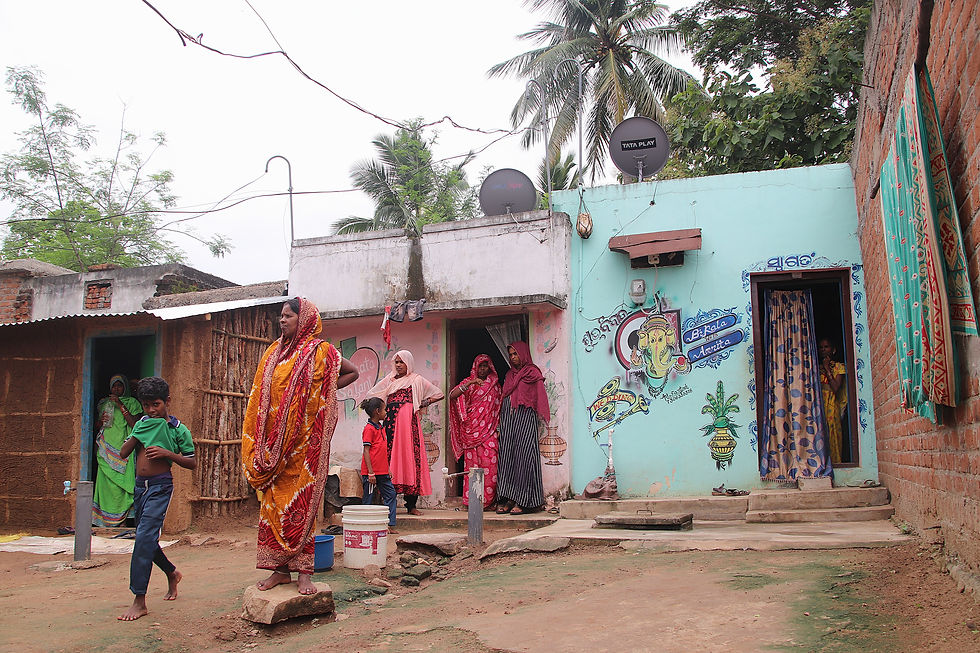
There are mainly women in most homes in Kusungadia village, as the men move to other states to work.
Aishwarya Mohanty/The Migration Story
According to the state government’s Labour Directorate, Ganjam is among Odisha’s 14 migration-prone districts, regions from where large numbers of people move out seasonally or permanently in search of work.
Other similar areas among the state’s 30 districts include Balangir, Mayurbhanj, Kalahandi and Koraput, located in western and southern Odisha, where deep poverty, erratic rains, failing crops and limited non-farming employment force families to seek wages elsewhere, usually under precarious and exploitative conditions.
More than 400 migrant workers from Odisha have died over the last nine years while working in other states, according to Labour and Employees’ State Insurance Minister Ganesh Ram Singhkhuntia.
In December 2024, in a written reply to a question by legislator Tankadhar Tripathy from Jharsuguda, Singhkhuntia informed the Odisha Legislative Assembly that 233 of the 403 total deaths have occurred since 2022.
Ganjam reported the highest number of migrant worker deaths, with 59 fatalities recorded between 2015 and November 27, 2024. It was followed by Kalahandi with 39 deaths, and Balangir with 35.
Men have been leaving Odisha for more than five decades to build roads, lay bricks, dig trenches, and carry cement in other states. There is a lack of consolidated data or official figures because much of this migration is not accounted for.
Surat in Gujarat is among the preferred destinations for migrants from Ganjam, but most families, especially from Dalit communities, started opting for Kerala because of caste-based discrimination in the former and better remittances in the latter, The Migration Story previously reported.
Thakur Naik, who worked at construction sites in Kochi, left home when he was 19, following his elder brother, cousins and other villagers.
The work is insecure, their lives precarious, and many die away from their loved ones. Some return wrapped in plastic sheets, ferried across states at crushing costs, or cremated by strangers in an even stranger land when their families are unable to arrange funds.
For those whose bodies do come home, the journey is fraught with bureaucratic hurdles, paperwork, mounting debt and the often unaffordable cost of performing dignified last rites. And where governments fail, non-profit groups sometimes step in.
The cost of dying
After Thakur’s sudden death in Kochi, his cousin Prabhakar said local ambulance service providers “claimed they would charge a minimum of 70,000 rupees to take the body to our village”.
The pressure from the agents linked to the ambulance services was relentless, with further negotiations only leading to an increase in costs. “They were constantly around us, telling us there was no other way to take the body back,” he said.
Language barriers compounded their grief, Prabhakar said, as it was challenging to understand the procedures. Staff at the mortuary often seemed too busy to answer questions. Naik’s elder brother and cousin had no space to shelter near the hospital while they waited.
“We didn’t know whom to trust or where to go for help,” Prabhakar said.
“Thakur sent whatever he earned back home so the family could survive. His parents had nothing. There was no time to even sit with the loss or cry in peace. We had to arrange the money somehow. The only option left was to take a loan.”
So began their desperate struggles. “All of us from the village [who were with him] in Kerala thought of pooling in money. One would think that 30,000 rupees is a small amount, but it is a huge amount for us and this isn't the only expense we were looking at,” Prabhakar said.
Back in Kusungadia, Naik’s immediate family reached out to anyone who might help - other villagers, local leaders and labour contractors. Some promised to help, but no money came through.
“When someone dies like this, you don’t even get to grieve properly. You are forced to think about how to bring the body back home first,” Prabhakar said.
Naik’s body lay in the hospital mortuary for two days. When the authorities handed it over to his cousin, the money hadn’t yet been arranged.
“Finally, we had no choice,” Prabhakar said. “We cremated him in Kerala itself. What could we do with the body?”
It’s been two years since Naik’s death, but in Kusungadia, his mother still awaits his return - his plate has been set aside, his clothes are folded neatly in a corner. The guilt of not seeing his face one last time still clings to her.
‘He wanted to rest, he was coming back home’

Sukanti Pradhan holds on to the only photograph of her husband in Borda village in Ganjam district as she endures the long wait for his death certificate. Aishwarya Mohanty/The Migration Story
In another part of Ganjam, Sukanti Pradhan, in her early sixties, sits in the veranda of her house in Borda village.
Her husband, Balram Pradhan, was supposed to walk through it one last time, as he had promised before leaving Kerala, where he worked for more than 40 years. He was unwell, tired of the endless cycle of migration, and had decided to return home for treatment. At 66, he thought he had worked enough.
But Balram never made it back. In August 2024, while travelling on the train from Kottayam, where he worked as a daily wage labourer, he died mid-journey. At the next station in Tenali, Vijayawada, in Andhra Pradesh, his body was taken off the train.
“We had three daughters and no son. My husband did not want to depend on my daughters and wanted to take care of both of us, and so he continued working even at this age. He kept saying that now he was tired and wanted to rest, and so he was coming back home,” she told The Migration Story.
One of his sons-in-law went to Tenali to bring Balram’s remains to Borda. But the police insisted that the new widow come to identify the body.
“My health is not always good. And I have hardly left home to go to a different state and city. How will I understand their language?” Pradhan said, eventually accompanied by her nephews and a neighbour.
She rented a Bolero, which cost 25,000 rupees to cover a distance of 600 kilometres, to reach her husband.
The return journey was another battle.
The family had to hire an ambulance, paying 40,000 rupees, borrowing from moneylenders in Odisha at an interest rate of 2 rupees per 100 rupees, per month. They paid another 1,00,000 rupees for funereal rituals, which included a three-day bhoj for the villagers.
Ten months later, Pradhan has still not received her husband’s death certificate. Without it, she cannot receive a pension for widows or government compensation schemes meant for bereaved families of migrant labourers. This could amount to 3 lakh rupees for organised workers in case of death and 2 lakh rupees for unorganised workers.
“I will have to travel to Tenali again to get the death certificate, which means an additional loan. I am old and I do not know how to do it alone,” said Pradhan, who has no other source of income and is yet to repay the last loan.
Death is not the end
In Ganjam’s Sapua village, when Kalpana Naik looks at her children, her four-year-old daughter and 18-month-old son, she often wonders what she will tell them about their father when they grow up.
Her husband, Upendra Naik died in August 2024 in Kochi. He was in his twenties. They were married a mere four years. They never took a photograph together, not even at their wedding, which took place without fanfare in the midst of lockdowns during the Covid-19 pandemic.
The two-room house, in which Upendra’s parents also live, has no photograph of his either.
“He wasn’t fond of photos,” she said.
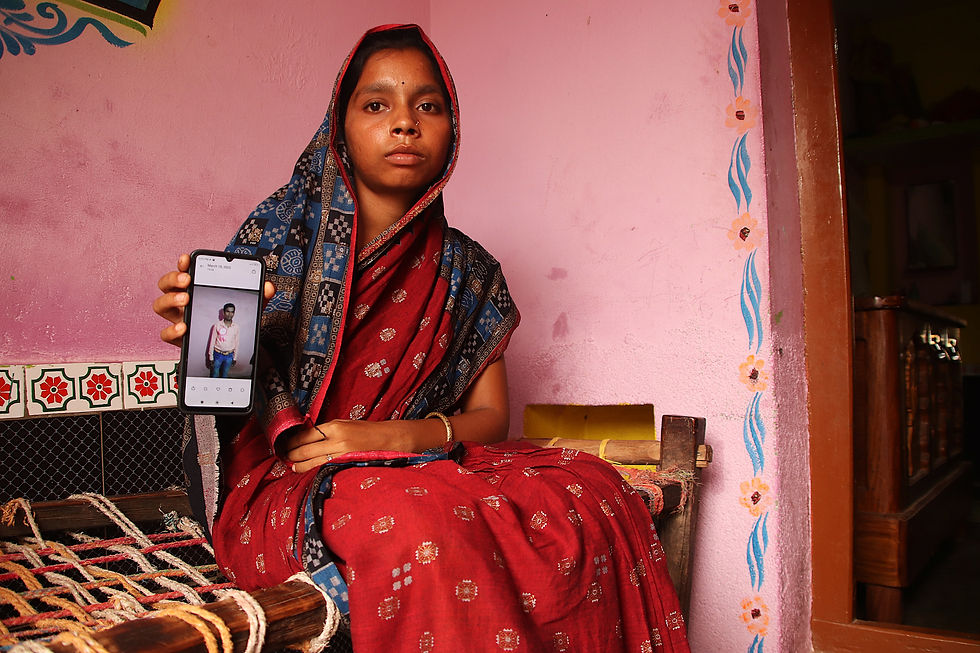
Kalpana Naik shows the only photograph she has of her husband Upendra on her phone at her home in Sapua village, Ganjam district. Aishwarya Mohanty/The Migration Story
“He called every day,” Kalpana said. “Mostly to ask about my health and to see the children’s faces on video.”
Upendra, who laboured at construction sites in Kerala, started working in the southern state two years before he got married.
Two months before his death, he had left Sapua village for Kochi, his return to work delayed as Kalpana had been unwell. But survival had become difficult with no income. He managed to send up to 4,000 rupees every week, Kalpana said, which kept the family going. After his death, their meals of rice, dal, and vegetables have been reduced to pakhal (fermented rice water) and potatoes, she said.
The day she got the call from the police station, Kalpana could not understand a word.
“The officers spoke in a language I did not know. I sent my brother to find out what had happened. He was there [in Kochi] too. He informed me of his death,” she said.
Kalpana still doesn’t know how Uprendra died or what his last hours were like.
Unaware of the next steps, she reached out to a field officer of Gram Vikas, a non-government group that works with rural communities, through another villager.
Over the last two years, Gram Vikas, in Odisha and the Centre for Migration and Inclusive Development (CMID) in Kerala have assisted in the repatriation of 63 bodies of migrant workers to Odisha.
The two non-profits have been working with migrant workers since 2019 but have, since 2022, been more formally involved in the repatriation process and keeping records.
The database, accessed by The Migration Story, shows most of these deaths occurred among migrants working in Kerala, particularly in districts such as Ernakulam, Thrissur, and nearby areas. There were also some in Tamil Nadu and Andhra Pradesh, particularly involving workers who died en route home.
The deceased were typically in their early twenties to late thirties, with some exceptions. The causes of death ranged from road and train accidents to workplace incidents, dengue and cardiac arrest. There were a few cases of suicide.
In the majority of deaths, the families chose to bring the bodies back despite the high costs, while in others, local cremations had to be arranged because of financial or logistical constraints.
“We get information about such deaths from our ground networks, sometimes at the source and sometimes at the destination, and while we can act as service providers in these situations, in the long run, there has to be a proper system in place,” said Liby Johnson, the executive director of Gram Vikas.
Information about migrants’ deaths often comes to light in their home state via families who then reach out to the NGOs or labour officials. Community members also inform field teams or Pravasi Mitras, the cadre of migration service providers for the NGOs.
In other instances, the news about a death comes from the destination, through migrants, a helpline started by Gram Vikas and CMID, or word of mouth, most commonly in Kerala, where some coordination systems exist.
The helpline is manned by one person each in Odisha and Kerala, on their mobile phones. They coordinate via the non-profits’ WhatsApp group, and then with the families, employers and labour contractors. The police need to be contacted for a First Information Report (FIR) if needed, followed by a post-mortem at a hospital, and then the labour department.
If the migrant dies at the workplace then the employer must get involved and take care of the expenses.
Once a death is verified, a long and complex process begins.

A field worker from Gram Vikas speaks to the mother of Upendra Naik in Sapua village. Upendra Naik died in August 2024 in Kochi. Aishwarya Mohanty/The Migration Story
“It usually takes 3-4 days if the case is not complicated, but it can even take more. We have to be at it if the body has to be brought back to the village. There is no other option,” said Trilochan Jena from Gram Vikas.
Depending on feasibility and the wishes of the families, the bodies are flown to Bhubaneswar or Visakhapatnam and taken onwards by ambulance, or sent by train to Brahmapur, a major rail link in Ganjam with the most connectivity to other states, before the final road journey home.
In some cases, when it is impossible to bring them back, cremations are arranged at the destination.
Even when their loved ones return, the struggle does not end for the families. It is only the beginning of a battle with paperwork, officials, and the unyielding machinery of compensation.
‘We have lost everything’
Kalpana has no photograph of Upendra, but what she does have is a bag full of documents - his death certificate, bills, transport receipts, letters she has written to the Collector seeking reimbursement, his Aadhar card and a passport-size photograph that is fading with time.
She keeps them carefully in a tin box, carrying them each time she visits the labour office in Berhampur, nearly 60 kilometres from her home. She has already travelled there twice, only to hear that her documents are “under verification”.
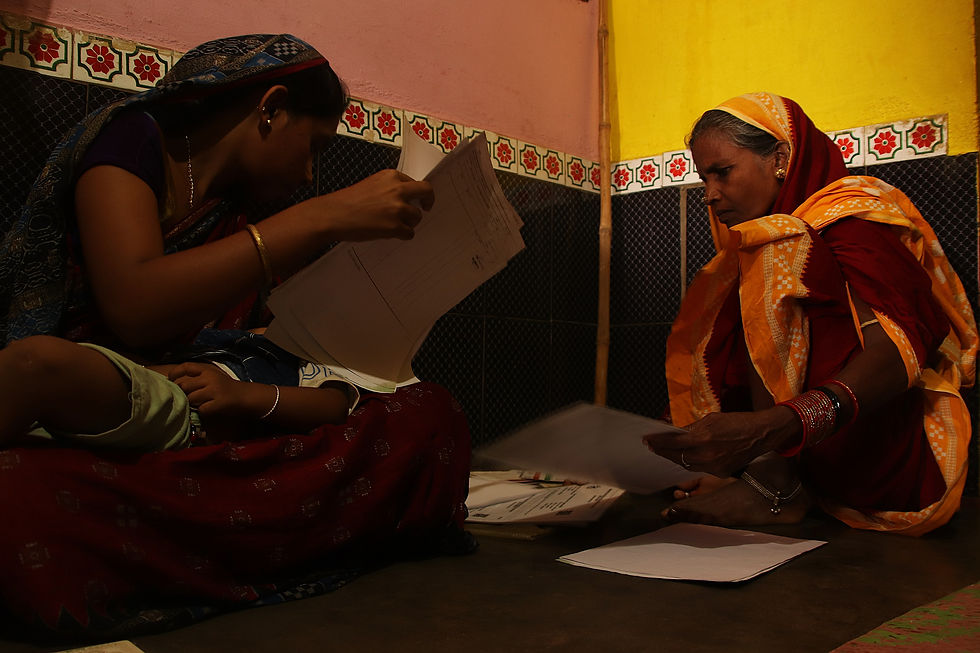
Kalpana Naik and her mother-in-law scour the documents they have kept safely at their home in Sapua village in Ganjam district, as they wait for compensation from the authorities. Aishwarya Mohanty/The Migration Story
“I have been asked to keep these papers carefully. So I do. We spent nearly 1,00,000 rupees to get his body back and perform all the final rites. We took a loan of 60,000 rupees. For the rest, Gram Vikas helped us crowd fund the amount. We are hopeful that we will get compensation and will be able to repay the loan,” she said.
In the meantime, Kalpana plans to take up contractual farm work during the monsoon months. But it will only be two months of work, and the wage is 250 rupees a day. She is waiting for her son to grow up a little more before she can step out to earn a regular income.
Johnson said the process becomes extremely difficult for grieving families.
“The family is in Odisha while the death happens in another state. To bring the body back, they need documents like the post-mortem report and FIR from the destination state,” Johnson said.
“It is not an easy task for any family, especially when they are dealing with the sudden loss of their loved one. Sometimes, official letters need to be translated because they are in different languages.”
Barely 10 kilometres from Sapua, Chandan Das’ father is undergoing the same ordeal.
Das’ journey ended before he could reach home. Born in 1991 in Khariguda village, he was returning home from Kerala in April 2024 when he fell off the train and died. His father received a call at 10 pm from the police, informing him of the death of his only son. With no money to travel, relatives reached out to Gram Vikas for help to bring back his body.
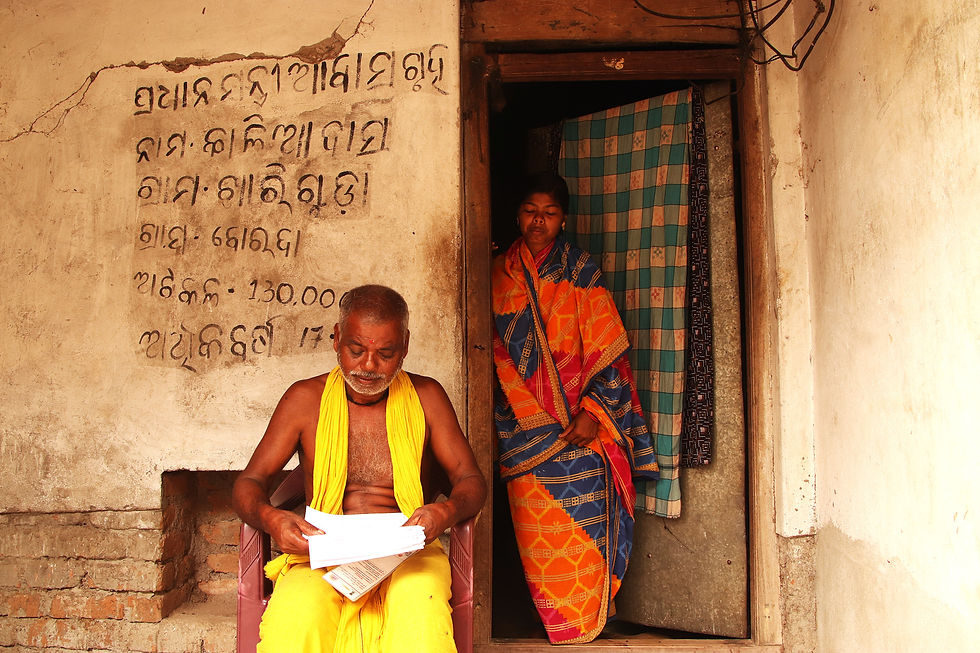
Chandan Das’ father Hira and younger sister at their home in Ganjam district, trying to make sense of his death and the reams of documents they have submitted for monetary compensation.
Aishwarya Mohanty/The Migration Story
Rummaging through a pile of papers, the father, Hira Das, said, “It took me 10 days to get all these documents in place. I keep them safe. But I do not understand most of it. I lost my young son. Nothing can compensate for it.”
“But I was told that there is a provision [for compensation]. I have a daughter whose wedding is due next year. That money could help us,” he said.
Johnson said families don’t know where to go or whom to approach, adding that “there needs to be a clear, time-bound Standard Operating Procedure for reimbursements and repatriation support”.
Rebati Naik is in a similar situation after her husband Tuna Naik died under the wheels of a heavy vehicle while walking back from work in Kerala in June 2024. It was raining, he told his wife in his last phone call. “I am under a shade. Will go home after the rain stops.”
His family learnt of his death only after a fellow villager called the next day, as the police could not communicate in Odia. His body arrived four days later, flown from Kochi to Bhubaneswar and then ferried in an ambulance costing more than 1,10,000 rupees, the crowd funding coordinated by Gram Vikas, whom they approached.

Rebati Naik was four months pregnant when her husband Tuna died 1,700 kilometres away in Kochi. She is now left to raise her children by herself. Aishwarya Mohanty/The Migration Story
Their house, a long mud room structured like a train compartment, was painted after his death, and again after his first death anniversary this year.
But little has changed for the family in a year, apart from the freshly painted wall.
Rebati, four months pregnant at the time, now lives with her elderly in-laws and sister-in-law, managing household expenses by working as farm help when it’s available.
“I have no hope of getting any money back. I have an infant and I cannot carry him everywhere … We have lost everything we had anyway,” Rebati said.
They have no ration card or savings. Only a passport-size photo of Tuna remains.
“The system is not family-friendly. Most of these deaths occur among informal sector workers, and there is a complete lack of convergence between departments,” Johnson said.
The Gram Panchayat should play an important role in maintaining migrant records and coordinating with the labour department in such cases, according to Johnson.
Flawed and discordant policies
In 2022, a Kerala Labour Department scheme that offered migrant families up to 50,000 rupees as financial aid for the repatriation of remains was changed to a reimbursement model, with the government citing a lack of funds.
This shift forced families to pay the entire amount upfront and apply for reimbursement within seven days, which was “an almost impossible deadline”, said Benoy Peter, the executive director of CMID.
“Critical documents like legal heirship certificates and postmortem reports take at least three weeks to obtain. As a result, most families, especially those who had already returned home, could never claim this support,” he said.
Families who couldn’t afford the cost were forced to cremate their loved ones in Kerala or take large loans and sell assets to take the bodies back, said Peter.
“The absence of formal coordination between police, health, and labour departments has meant that many workplace deaths now go unreported, affecting legal recourse and tribunal proceedings,”he said. “This gap has allowed middlemen to thrive, charging exorbitant rates, up to 70,000 rupees for air repatriation and over 1 lakh rupees for ambulance transport.”
The families that The Migration Story spoke to are from Dalit communities, making them more vulnerable to systemic neglect and financial exploitation.
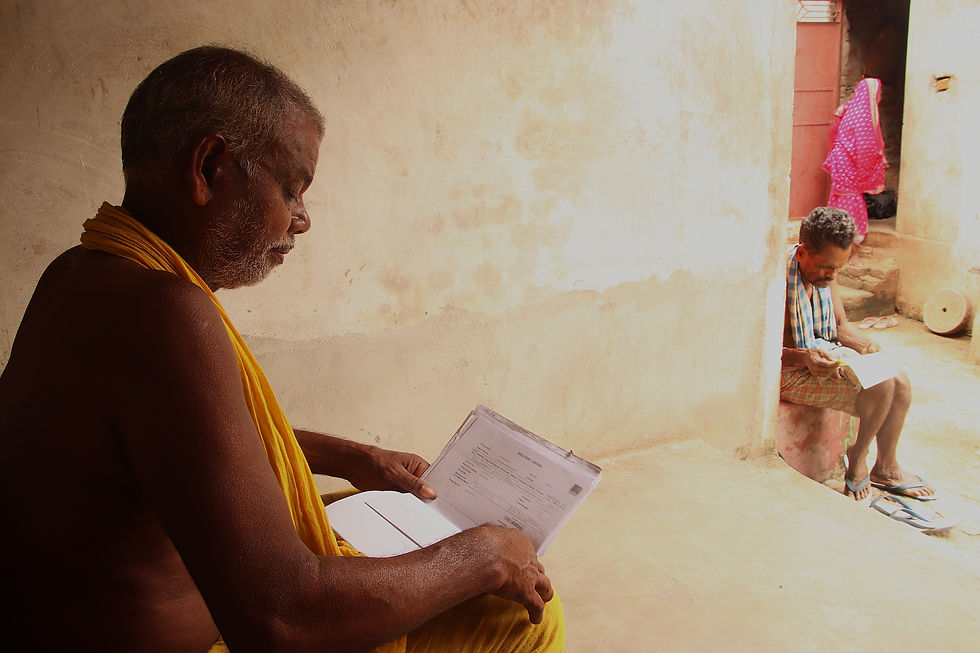
Hira Das doesn’t understand most of the documents related to his son Chandan’s death, which he says nothing can compensate for. Aishwarya Mohanty/The Migration Story
Labour department officials said inter-state migration deaths often come to their notice through family members, media reports or groups such as Gram Vikas.
“The block-level labour officer then visits the village, meets the family, verifies the information, and coordinates with the labour officer at the destination,” said Prakash Parida, Assistant Labour Officer, Berhampur.
The department has a migration fund specifically to support the repatriation of bodies, he told The Migration Story, which “is available to both organised and unorganised workers who hold valid labour cards”.
But he admits that gaps remain particularly when the workers are not registered, adding that “then the family has to approach the Collector or seek a court order for any compensation. It is not in our hands in such cases”.
Workers are expected to apply for either an organised labour card or an unorganised labour card with the district labour department, the latter covering nearly 50 types of occupations. Under existing provisions, the compensation is 3 lakh rupees for organised workers and 2 lakh rupees for unorganised workers in case of death.
Registration remains poor despite multiple awareness programmes.
“There is a huge gap between the number of people migrating and those registered. They have the freedom to move, it is their fundamental right - we cannot stop them,” Parida said. “But if they don’t register, it becomes very difficult for us to help.”
The state database currently only has records of workers migrating through registered contractors, leaving out a large, invisible segment of Odisha’s migrant workforce.
The Migration Story reached out to the Labour Commissioner’s Office in Kerala, which is yet to respond.
Migrants continue to leave home in large numbers despite all the challenges.
“How will we sustain our families if we do not migrate?” Prabhakar said.
“There is no work here that pays enough. Migration is the only way we can buy rice for our children,” said Bishnu Naik, another migrant from Kusungadia village.
“We know the risks, accidents, illness, exploitation, and even death far from home. But for us, it is an accepted part of life. Death feels inevitable, but poverty feels worse,” he said.
“The only pain is that we do not get to meet our families one last time,” said Prabhakar. “After all, we go there only to earn for them. When someone dies there, at least his body should come back. That is our only wish.”
Edited by Anindita Ramaswamy
Aishwarya Mohanty is a freelance journalist and reports on gender, climate change and environment. She has researched the subject for Gram Vikas Community Development Foundation that works with informal workers and rural communities
This story is the first in a three-part series - The Job Cycle - that will document stories from the Odisha-Kerala migration corridor





Comments